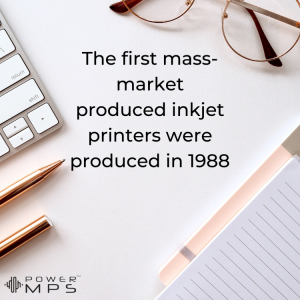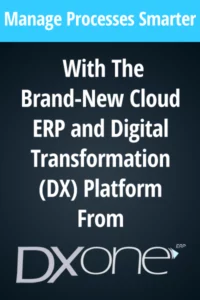Most office workers have a certain level of familiarity with corporate-level laser printers and copiers. The smell of toner and the warmth of the paper as it comes out of the machine might even bring a bit of nostalgia. There is even a line of candles available for everyone who miss life pre-pandemic, including “Warm 96-Page Deck Left On the Printer”.
Most people’s experience with inkjet printers is relegated to small consumer-grade contraptions. For many, that means wet paper and ink cartridges that cost more than the original device. But inkjet printers can be fantastic devices that produce extremely vibrant and high-grade images. They are also typically built in smaller footprints than office-grade laser printers, something appealing to small-to-mid-sized businesses and small workgroups. As of 2019, inkjet printers accounted for close to 48% of office printer shipments. But what makes inkjet printers so different from the usual business monstrosity?
The Invention Of Inkjet
Unlike the ironing board, the three-light traffic signal, or Kevlar, the inkjet printer is not attributable to a single inventor. Credit for the development of the original design is given to several printer companies, including Epson, HP, and Canon. Originally developed in the 1950s, it was not until the late 70s that inkjet machines were capable of reproducing computer-generated images similar to what we use them for today.
The original inkjets were usually large, clunky, and struggled with technical issues. Just as today, the quality of an inked print depends on the ink used, the status of the print head and the paper pushed through the machine. But older ink printers had difficulty keeping print heads from clogging and managing how and when the ink was dispensed.
Eventually, IBM developed the continuous inkjet printer, which used electrically-charged droplets to coat pages quickly. The method was far from efficient and typically wasted large quantities of ink. The method is still used in some industrial settings such as address printing for direct mail and carton labeling. However, it was not a process conducive to office or consumer print jobs.
Drop-On-Demand
called “drop-on-demand” (DOD). It proved to be the breakthrough the industry needed to push inkjet printers beyond the commercial space. Other manufacturers were quick to innovate on the technology, creating new ways methods to deliver the ink for DOD printing.
Japanese-based Canon was one of the first to discover that the application of heat to ink could cause droplets to shoot out of a syringe. They inserted heating elements into their printer cartridges. A pulse of electric current would then run through the element to generate a bubble in the ink chamber, increasing pressure and propelling an ink droplet out of the nozzle and onto the paper. Canon dubbed it “bubble jet” printing. HP, Lexmark, and other print industry giants were not to be outdone. Seeing Canon’s bubble jet solution, they pulled together similar heat-based technology for their own machines, dubbing it thermal printing.
Epson, on the other hand, took a different route to manage their ink delivery. Rather than using heat, their systems rely on a material with properties similar to magnets, called piezoelectric material. When an electric current is applied to the piezoelectric element, the material changes shape. This change generates the pressure needed to push ink droplets from the cartridge’s delivery nozzle.
Making Things Affordable
 The first mass-market, consumer-grade inkjet printers were produced by Hewlett-Packard in 1988. They were priced at around one thousand dollars. Office printers were magnitudes more. Today, consumer inkjets are extremely inexpensive, often sitting somewhere about thirty dollars. Reliable inkjet printers for business, on the other hand, have slowly lowered in pricing closer to the thousand dollar range for the more compact, table or desktop versions. Enterprise models include additional features and functionality while moving up significantly in the pricing structure.
The first mass-market, consumer-grade inkjet printers were produced by Hewlett-Packard in 1988. They were priced at around one thousand dollars. Office printers were magnitudes more. Today, consumer inkjets are extremely inexpensive, often sitting somewhere about thirty dollars. Reliable inkjet printers for business, on the other hand, have slowly lowered in pricing closer to the thousand dollar range for the more compact, table or desktop versions. Enterprise models include additional features and functionality while moving up significantly in the pricing structure.
Unlike consumer-grade printers, which rely heavily on ink sales to produce profits for the manufacturer, office printers are an upfront cost with lower per-page expenses. And inkjet manufacturers are working hard to match the efficiency and affordability of their laser printer competitors through innovations such as high yield ink cartridges. Some of the more recent versions are capable of producing over seven hundred and fifty pages per cartridge.
In addition, to increasing the number of prints per casing, inkjet manufacturers also offer their ink at a lower cost per cartridge. As of late 2021, many popular high yield cartridges had a standard price of fewer than thirty dollars.
Why Select Inkjet
Despite the growing affordability of inked prints, a price-only comparison to their laser competition is sure to favor laser printing. Inkjet is not the preferred choice for businesses that produce largely black-and-white materials. However, for graphics-heavy organizations such as sales, graphic design, and marketing, inkjets provide the vibrancy of color required to help convey the right message and imagery to executives and clients.
Companies who are wondering whether an inkjet printer is right for their business should contact a printing expert such as managed print services, printer servicing, or printer leasing provider. These organizations specialize in providing printers for a wide range of organizations and can provide in-depth recommendations about the types and models of printers that will be the best fit for a particular business.







